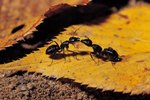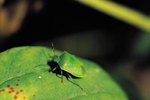
Insects are some of the most versatile creatures of all. After all, they can pop up almost anywhere, whether in your kitchen cabinet or in a restaurant's Dumpster. Acheta domesticus, otherwise known as the house cricket, is no exception. These crickets appear everywhere from building interiors to meadows.
Natural Habitat of Acheta Domesticus
The natural habitats of Acheta domesticus are diverse. Some common sites for house crickets are woodlands, caves, pastures, fields, below logs and rocks and on the sides of roads. House crickets also enjoy settling inside of heaps of wood, brick and stones. The insects are also often found in damp and soggy areas that are full of weeds, high grasses and mulch. They are a relatively common sight over much of the planet; within the United States, they are especially prevalent in regions east of the Great Plains.
Common Spots Near Human Beings
House crickets also often reside in very close proximity to human beings—that's how they got their common name. They are very attracted to warmth. Where house crickets can receive sufficient sustenance and wetness, they will likely stick around. The crickets often exist in areas surrounding both homes and commercial buildings, as well as in trash dumps, siding and ducts, near furnaces, close to water heaters, in skylights on roofs, in kitchens and by fireplaces.
Cold-Weather Survival
House crickets that live in natural outdoor habitats typically—although not always—die when it becomes cold outside. However, those crickets that spend all their time within buildings often stay alive no matter the weather conditions. Because of this, many house crickets make the transition from outdoor living to indoor living around the end of the summer, according to the Dallas Zoo.
Time of Day
Acheta domesticus are nocturnal. During the dark night hours, many house crickets are drawn toward lighted buildings, according to the University of Missouri Extension. When it is light out, house crickets often spend their time perfectly out of sight.
References
- Reed College: Behavior of the House Cricket, Acheta domesticus [PDF]
- University of Florida Entomology & Nematology: House Cricket
- Dallas Zoo Conservation Education & Science: House Cricket
- ASU School of Life Sciences: House Cricket
- Clemson University: House and Field Crickets
- University of Missouri Extension: House-Invading Crickets
- Michigan State University Extension: Crickets
Photo Credits
-
George Doyle/Stockbyte/Getty Images




